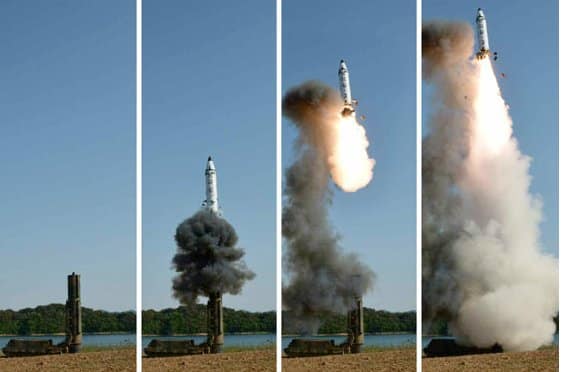The Pukguksong-2 (US designation: KN-15) is a North Korean medium-range ballistic missile (MRBM) derived from the Pukguksong-1 submarine-launched ballistic missile.
Pukguksong-2 (KN-15) at a Glance
- Originated from
- North Korea
- Alternate names
- KN-15, Pukkuksong-2, Bukgeukseong-2, KN-11 Mod 1
- Possessed by
- North Korea
- Class
- Medium-range ballistic missile (MRBM)
- Basing
- Road-mobile, tracked transporter-erector-launcher
- Length
- 9 m
- Diameter
- 1.5 m
- Payload
- Single warhead
- Propulsion
- Two-stage, solid propellant, cold-launched
- Range
- 1,200 – 2,000 km
- Status
- Operational
- In service
- 2018 – 2019



Pukguksong-2 Development
The Pukguksong-2 is a land-based variant of the Pukguksong-1 submarine-launched ballistic missile, whose began some time before 2014.
North Korea first flight tested the Pukguksong-2 on February 12, 2017 from an airbase in the country’s western North Pyongan province. According to South Korean authorities, the missile flew 500 km and reached a maximum altitude of 550 km before landing in the Sea of Japan. While South Korea initially suspected that the test involved a Nodong or modified Musudan missile, North Korean state media announced the successful test of the Pukguksong-2 “Korean-style new type strategic weapon system” several hours after initial reports.1
On May 21, 2017, North Korea launched a second Pukguksong-2 from Pukchang, roughly 70 km north of Pyongyang. The missile flew 500 km, reached a maximum altitude of 560 km, and landed in the Sea of Japan. North Korean state media hailed the launch as the Pukguksong-2’s last developmental test, claiming that authorities had approved the system for serial production and deployment.2
The Pukguksong-2 has entered combat service and its launch vehicles have featured in larger numbers at recent North Korean parades. In 2019, the United Nations confirmed that North Korea had deployed the Pukguksong-2 at its northern missile bases. 3 The United States’ National Air and Space Intelligence Center has also listed the Pukguksong-2 as a deployed system.4
Pukguksong-2 Design
The Pukguksong-2 is a two-stage, solid-fueled medium-range ballistic missile. The missile has an estimated length of roughly 9 m and an approximate diameter of 1.5 m, similar to the Pukguksong-1. While the missile flew 500 km in tests, analysts estimate that a Pukguksong-2 fired at a shallower trajectory could range between 1,200 and 1,300 kilometers. The Pukguksong-2’s range may be significantly shorter with heavier payload configurations.5
North Korea developed the missile’s solid-propellant motor indigenously, and later showcased a composite motor casing at its Chemical Material Institute in Hamhung.6 The missile is launched from a sealed canister using a cold-launch system, which generates pressurized steam or other gas to propel the missile several meters upward. After ejection, the missile detaches its gas-generation system and fires its main solid-propellant booster. North Korea previously employed a cold-launched system on its Pukguksong-1 submarine-launched ballistic missile.
The missile employs a tracked vehicle for transport and launch. This tracked transporter-erector-launcher (TEL) differs significantly from North Korea’s earlier mobile missiles, which use wheeled TELs limited to operating on relatively smooth roads and other prepared positions. The Pukguksong-2’s tracked TEL may offer enhanced survivability, as its off-road mobility would increase the number of locations where it could launch and hide. This capability is particularly suited for North Korea, which has only around 700 km of paved road throughout the country. 7 It is believed that North Korea indigenously developed the Pukguksong-2’s TEL.
Footnotes
- “N.Korea test-fires modified Musudan missile,” Yonhap News, February 12, 2017; Dagyum Ji, “N. Korea successfully test-fired medium long-range missile: KCNA,” NK News, February 12, 2017, https://www.nknews.org/2017/02/n-korea-successfully-test-fired-medium-long-range-missile-kcna/?c=1495402842202.
- Dagyum Ji, “N. Korea announces Pukguksong-2 launch, says missile can now be ‘mass-produced,’ NK News, May 21, 2017, https://www.nknews.org/2017/05/n-korea-announces-pukguksong-2-launch-says-missile-can-now-be-mass-produced/.
- United Nations Security Council, “Report of the Panel of Experts established pursuant to resolution 1874,” United Nations, August 30, 2019, https://undocs.org/en/S/2019/691, 135.
- Defense Intelligence Ballistic Missile Analysis Committee, Ballistic and Cruise Missile Threat 2020, (Wright-Patterson AFB, OH: National Air and Space Intelligence Center, July 2020).
- Choe Sang-Hun, “North Korea Missile Test Was Short on Distance but Long on Data, South Says,” The New York Times, May 22, 2017, https://www.nytimes.com/2017/05/22/world/asia/north-korea-missile-test.html; Kelsey Davenport, “North Korea Tests New Missile,” Arms Control Today, March 1, 2017, https://www.armscontrol.org/act/2017-03/news/north-korea-tests-new-missile; Defense Intelligence Ballistic Missile Analysis Committee, Ballistic and Cruise Missile Threat 2020, (Wright-Patterson AFB, OH: National Air and Space Intelligence Center, July 2020)
- “Kim Jong Un Inspects Chemical Material Institute of Academy of Defense Science,” Rodong Sinmun, August 23, 2017, archived, https://web.archive.org/web/20170826010535/http://www.rodong.rep.kp/en/index.php?strPageID=SF01_02_01&newsID=2017-08-23-0001; Michael Elleman, “Kim’s Visit to the Chemical Material Institute: A Peek into North Korea’s Missile Future,” 38 North, August 25, 2017, https://www.38north.org/2017/08/melleman082517/.
- Ankit Panda, “It Wasn’t an ICBM, But North Korea’s First Missile Test of 2017 Is a Big Deal,” The Diplomat, February 14, 2017, http://thediplomat.com/2017/02/it-wasnt-an-icbm-but-north-koreas-first-2017-missile-test-is-a-big-deal/.